Carillion: Difference between revisions
No edit summary |
|||
| Line 69: | Line 69: | ||
[[Image:Carillon 11.JPG|200px|thumb|right| Carilloneur Mr. Jerry Dadap]] | |||
{| class="wikitable" border="1" | {| class="wikitable" border="1" | ||
|- | |- | ||
Revision as of 10:28, 13 March 2012
Carillion
Osmena Avenue, Diliman, Quezon City, National Capital Region, Philippines
Art Studies 2 THR-2
Sir Roberto G. Paulino
by:
Alvin Bacero Bello
Maria Cristy Borcelis Buban
John Martin Rabino Caquilala
Reported and Edited by:
Maria Riva Gil Ferrer
I. Overview
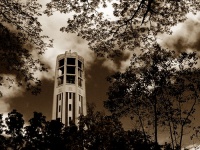
According to the "New Grove Dictionary of Music and Musicians", a carillon (n.) is a set of stationary bells normally in a tower or high outdoor frame, for playing music.
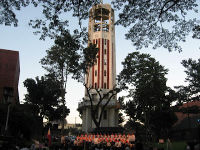
The University of the Philippines Memorial Campanille is a musical instrument with 46 tuned bells1 sounded by the hammer keys of a clavier, controlled from a keyboard or clockwork mechanism. When it played, the sound of the bells could be heard from all four corner of the campus - classrooms, laboratories, janitorial closets. It was a solace democratized. Besides it being a soothing voice from a distance, it is also a landmark, a time-keeper, and a memorial to the spirit of the U.P. Alumni, living and dead.
II. History
"With the possible exception of the Oblation statue, nothing symbolizes the University of the Philippines more than the 130-foot Carillon Tower - a structure unlike any other in Diliman, a ringing echo of the University's glorious past." -Jose Dalisay Jr., PhD., writer2
The University of the Philippines Memorial Campanille was built in 1952 at a cost of some two hundred thousand pesos [P200,000.00], considering that $1.00 in 2012 has the same buying power as $0.12 in 1952. Annual inflation over this periodwa 3.36%.3 The Carillon Tower has serenaded U.P. students, lecturers, professors, employees, and campus residents of countless generations with songs such as U.P. Beloved [U.P. Naming Mahal], Planting Rice [Magtanim Ay Di Biro], The Beatles' tunes, etc. It grew timeless, giving the time every hour of the day, and to quote Dr. Dalisay: "...to remind the listeners that some things never change - love, honor, idealism, the joy and the challenge of learning beneath the broad canopy of a university life."
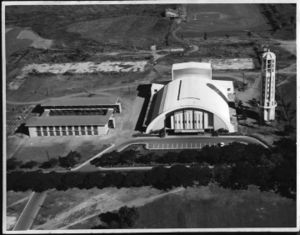
As early as 1940, National Artist for Architecture Juan F. Nakpil, a UP Alumnus and U.P. Music Conservatory director Ramon Tapales, together with U.P. President Bienvenido Gonzalez, had dreamt of building a carillon. Unfortunately, all the efforts towards its formation were paralyzed because of the World War II. However, after the country’s liberation, the plan was again brought forward at the time when the University was preparing to move from the bombed-campus in Padre Faura to the green hills of Diliman. On September 18, 1948, the plan was re-envisioned at a meeting of the board of directors of the UP Alumni Association, mobilizing to build the tower and buy and install the bells.
The bells of the carillon were casted by the Van Bergen Bell Company of Heiligerlee, Netherlands, Chimes and Carillon Foundry, of Greenwood, South Carolina and were delivered and installed under the supervision of a Dutch Carilloneur, Prof. Adrian Antonisse, director of the Music-school of Netherlands. Professor Antonisse became the first Carilloneur of the state university. The installation started from June and the last bell was set place on July 11. This was accomplished soon after the University transferred most of the units from Manila to Diliman.
It was the alumni who decided to donate the carillon as their contribution to the new campus. But due to lack of funds, the UP Alumni Association decided to create a funding committee.
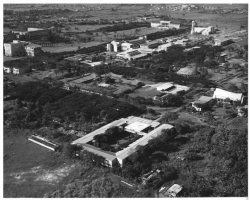
The Funding Committed formulated a project involving a nationwide campaign to raise funds for the purchase of the bells and the construction of the tower. The committee sent an appeal to more than 17,000 alumni all over the country. Struck by this gesture, the UP Board of Reagents authorized an advance sum for its construction with the understanding that the alumni association will pay them back.
President Elpidio Quirino was the first to respond to call giving an amount of Php 1000. Prof. Juan Nakpil, consulting architect of the University, donate an amount of Php. 5 000 in memory of Dr. Ariston Bautista Lin. Other early donors include Juan J. Carlos, practicing engineer of Manila who gave Php 500 and Capt. Alfredo G. de la Cruz of San Miguel Tarlac, Php. 10. Php. 90 000 was the target amount from all donors including the alumni, private individuals, fraternities and student councils making the project a labor of love.
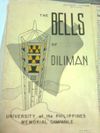
It was finally inaugurated by President Elpidio Quirino on August 1, 1952 in commemoration of the former President Manuel L. Quezon’s death. On August 3, 1952, Prof Antonisse was presented by the UP Conservatory of Music at a carillon concert. This was followed by a farewell concert on August 14 of the same year. College of Liberal Arts and the Conservatory of Music also sponsored two identical lectures on carillon bells and music by Prof Antonisse on July 24, week before the dedication of the UP Carillon.
On the first Christmas Eve with the carillon installed, it was heard for two solid hours until midnight, ushering in the birth of our Lord. Likewise, it was hard on the early Easter morning proclaiming our Christ arisen.
II. Structure and Design
Structure Overview
Generally constructed for bell towers,carillons are the heaviest of all extant musical instrument. They are usually made from bronze (80% copper+20% tin) to produce perfect tone and clarity. Bronze is much less prone to corrosion and much harder than brass thereby allowing carillons to retain its quality for decades. Carillons are connected through wires to the playing cabin where the clavier is installed. The playing cabin is position directly below the bellchamber so the clavier can be placed in the optimum position relative to the transmission system.The entire system is then housed inside a tower to protect and support the instrument.
The Tower
The University of the Philippines Memorial Campanile is a 130-foot structure with a carillon of 46 perfectly tuned bronze bells. The tower was built under the supervision of architect Juan Nakpil, a 1973 National Artist. The funds for its construction were provided by the UP Alumni Association and donors.
From the outside view, the tower is painted with cream and maroon. It has a very stable foundation and has a system of vertical lines (eight outside, four inside)supporting the structure. The top portion of the tower is an open bellchamber with a small dome ceiling. It houses and displays the bells to the public. A sight of an endless narrow spiral staircase skyward through 5 landings could be seen in the building’s interior.
The Bells
46 bells were installed up in the tower with the supervision of Professor Adrian Antonisse Jr., a Dutch carilloneur and director of Veendammer Muziekschool of the Netherlands. Those bells were casted by Van Bergen Bell, Chimes and Carillon Foundry. Some of the bells were named after individual donors. The largest bell which weighs about five tons was embossed of the names of the officers and the members of the board of directors of the alumni association. The last bell was set place on July 11, 1952.
The bells were tuned to the intervals of the chromatic scale similar to a piano, and having a range of three octaves or more. The bell which has the lowest pitch can weigh many tons. The smaller the size of the bell means the higher the pitch. The names of the Alumni Board and donors are inscribed on some of the bells.
There are two methods of playing the carillon. A carilloneur may strike a keyboard called a “clavier” which is similar to that of an organ but the difference is that it uses wooden pegs. According to Prof. Antonisse, one to two years of devoted study is necessary to master the instrument which requires a great deal of muscular effort to play because the fists are used in striking the keys. Each key of the clavier is connected to the clapper of the corresponding bell by means of wires and cranks. Those clappers are sufficient to bring out the full volume of sound required for carillon playing. Pedals are also attached to the levers connected with the heavier bells so that these can be played by foot. Recent development allowed for an alternative way of playing using automatic machine to play the carillon at pre-set hours.

| First Five Carilloneurs |
|---|
| Prof Adrian Antonisse Jr. |
| Mr. Wesley Tabayoyong |
| Cris Eva Gonzales |
| Jerry Dadap |
| Tony Regalaria |
Table 1 shows the first five Carilloneur of the University of the Philippines. Currently [2011-2012], U.P. Carilloneurs are Malvin Bethooven Macasaet, Bachelor of Music [BM] Conducting graduate pursuing his 3rd degree in BM in Voice, and Jesper Colleen Mercado, BM Piano, both from the U.P. College of Music.
III. Symbolisms and Struggles
Carillon as a symbol of Loyalty
Since it was the alumni association who mainly contributed in the construction of the Carillon, it was established that the tower symbolizes the Alumni spirit, love and loyalty. As per Juan Nakpil, the Carillon will serve as the emotional and spiritual link between the students, faculty, and alumni of the succeeding generations. He also added, “It will be a voice speaking to us from the midst of our campus – not from a distance”
Carillon as a symbol of Extravagance
Though UP Carillon has been a symbol for Alumni’s Labor of Love, it did not escape certain issues regarding its formation and structure. During the time of its construction, the state university was also suffering from an immense financial difficulty brought about by the war. Because of this, repercussions took place for some sectors of the university objected to the formation of the Carillon calling it a symbol of extravagance and not loyalty. They contented that the money spent for its construction should have been allotted in solving the monetary problems that plagued the University.
In response to this, the editor of the Collegian in that year wrote on his article, “We do not look at it that way. To us, the Carillon is a gift of the alumni and is symbolic of their regard to the Alma Mater. To us, the Memorial Campanile is the expression of their loyalty to the cause of education which the University is dedicated. That to us is the Carillon. If loyalty ever be a luxury then the Carillon and all that it stands for is luxury, indeed”“
Most of the University Officials believed that the Carillon symbolizes very important ideas and conceptsthat are priceless and are worthy of the enormous amount spent for its construction.
Carillon being tilted
The Carillon became controversial not also because of its monetary aftermath but also because of the assumption that the lofty structure is tilted. During that time, students of the university hoped to have another leaning tower like that of the Pisa in Italy. However, a study made by a group of Engineering professors proved that it was just an optical illusion. Only after this study did the hubbub ceased.
Carillon being out of tune
Aside from the fact that the bells are tuned in chromatic intervals and have a range of three or more octaves, the overtones and the harmonics produced by the bells are also arranged in an order way different from those given by the strings or by an organ. Because of these, listeners who are not familiar with the Carillon thought that our bells are out of tune.
Defending the Carillon, Arthur L. Bigelow said, “In contrast to other producers of musical tone, endowed by nature with a major third, the third of the bell is minor. It is this particular overtone which gives to the bell its plaintive note, so characteristic and so distinctive from all other instruments”
Truly, before one can fully appreciate the music of the Carillon, he must first learn to distinguish the humtones from the overtones. As what Prof Antonisse has said in one of his lectures, “You just don’t take Carillon Music. It is entirely different from other forms of music.”
IV. Restoration
With age and neglect, the Carillon may fall silent through the years. Even if the tower is firm and robust, the Holland-made bronze bells may go out of tune and the clavier may crumble over time. It was in 1988 when the Carillon was last heard and that was during the Lantern Parade. Since then, the tower has been used as a stockroom, an art studio, and for other various purposes. Previous restoration fell short of the funds needed for a complete overhaul.
Though, it was a unanimous decision. The U.P. Alumni Association [UPAA] thought of bringing back the "Bells of Diliman" in time for the University's Centennial Celebration in 2008. During the 92nd Alumni Homecoming in June 2005, the UPAA Board of Directors officially launched the U.P. Carillon Restoration Project.
The Projet Committee's main objectives are [1.] to restore the campanile, the tower, and the surroundings, which involves technical evaluations, fund raising, actual repairs and replacements, and the landscaping of the immediate environs; and [2.] to institutionalize the Carillon's operation and maintenance. Aside from preserving the bells' musicality and the physical upkeeps, the project includes maintaining a scholarship to ensure the availability of a steady pool of well-trained carilloneurs. Below is the proposed renovations4:
1. Bells. All forty six [46] bells will be replaced and three [3] more bells will be added in order to make all of them produce four octaves plus one note. After well-tempered electronic tuning, the Carillon bells will be concert-pitched and can play simultaneously with an orchestra or any musical group.
2. Clavier. The old clavier keyboard instrument will be replaced with a new one made of oak wood and designed for heavy-duty performances.
3. Computerized operation. In adition to manual playing of the clavier, it will be hooked-up to a master clock, a synthesizer, and a computer. This will enable the bells to be played automatically at specific times of the day.
4. Steel frames and other parts. The steel frames where the bells are suspended will be refurbished. Other important parts such as clappers, cables and steel wires, turnbuckle nuts and bolts, spindle springs, and miscellaneous items will be replaced.
5. Tower structure. Both the inside and the outside walls of the Carillon tower, the flooring and other concrete structures will be repaired, cleaned-up, and repainted.
6. Landscaping. The areas that surround the Carillon tower will be cleaned, grass and flowering plants will be placed in accordance with a well laid-out plan.
7. Carillon Plaza. The outer surrounding areas encircling the Carillon tower will be transformed into a flat amphitheater-like formation where concerts and musical performances could be held. Made of bricks, stones, and tiles, the names of the donors will be engraved in brass plates.
8. Operation and maintenance. Part of the funds to be raised will be used for proper maintenance of the Carillon tower on long-term basis. A Memorandum of Agreement with U.P. Administration will be entered for this purpose.
9. Scholarships. These will be granted to support the studies and training of potential carilloneurs in U.P. and other specialized institutions abroad.
V. Bibliography
Cabatuando, Patria "The Musical Tower". The Philippine Collegian. October 14, 1967.
Jorge, Rufina S.. Member of the U.P. Alumni Association. Alumna of U.P College of Music, Bachelors Degree, Major in Piano. Co-chairperson for the U.P. Carillon Restoration Project
Mendoza, Rene E. "The Carillon Story". The Carillon Overtones, Vol 1 No. 1 . March 1957.
Sadie, Stanley. Editor. "The New Grove Dictionary of Music and Musicians", Volume Three. Macmillan Publishers Limited. 1980
"Legend of the Bells". The UP Bulletin, Vol 3 No. 2 . September 1952.
"Carillon". The UP Newsletter, pp 5-6 . October 1973.
"Carillon on the Diliman Skyline". The UP Bulletin, Vol 1 No. 4 . August 1949.
"Carilloneur Speaks on Bells and Music". The UP Bulletin, Vol 3 No. 1 . July 1952.
"Kampana" featuring the University of the Philippines Madrigal Singers: a concert for the restoration of the U.P. Carillon. 2006.
"Now on its way are the UP Carillon Bells". The UP Bulletin, Alumni Homecoming Volume . April 1952.
Philippine Daily Inquire. December 5, 2007
The Philippine Star Lifestyle.September 12, 2005
"Quirino Donates P 1,000 to Carillon". The UP Bulletin, Vol 1 No. 4 . August 1949.
"Save The U.P. Carillon: A Centennial Project of the U.P. Alumni Association". pamphlet. 2005
"The UP Carillon Bells". UP Alumni Reunion Yearbook . 1953.
U.P. Alumni Association. booklet.
The UP Bulletin, Vol 2 No. 1 . January 1950.
Map
<googlemap lat="14.655216" lon="121.068091"></googlemap>
See Also
- Public Art at UP Diliman
- [1]Standard for Constructing Carillon Towers
1 as per all write-ups of the U.P. Alumni Asociation or UPAA [booklets, pamphlets, press releases, etc.]
2Jose Y. Dalisay Jr. (born January 15, 1954) is a Filipino writer. He has won numerous awards and prizes for fiction, poetry, drama, nonfiction and screenplay, including 16 Palanca Awards. See also Jose Dalisay
3 according to www.dollartimes.com
4 for more information, you may visit www.upcarillon.org


